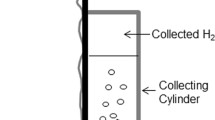Abstract
The presence of hydrogen in aluminium poses problems to the foundry and casting industries, because high residual hydrogen contents in molten aluminium cause significant porosity in the solid aluminium after casting. This usually renders the product useless as it may fail mechanically. Therefore, fast, accurate and reliable techniques are required for monitoring the dissolved hydrogen content in molten aluminium, but this particularly harsh environment places considerable restrictions on the equipment that can be used. Several methods are available for the determination of hydrogen in aluminium melts, but they either suffer problems of accuracy, reliability and longevity or are not applicable to industrial environments. It is considered that the most appropriate device for the hydrogen analysis in aluminium melts should be an electrochemical sensor, which employs a proton conducting solid electrolyte in conjunction with a measuring electrode and a suitable reference electrode. The electromotive force of such a cell allows direct calculation of the hydrogen concentration in the melt. However, all the electrochemical sensors reported in the literature thus far exhibit distinct drawbacks. This article discusses the various techniques for the determination of hydrogen in molten aluminium with particular emphasis on the benefits and shortcomings of the existing electrochemical sensors.
Similar content being viewed by others
6. References
C.E. Ransley and H. Neufeld, J. Inst. Met.74, 599 (1948).
P.M. Thomas and J.E. Gruzleski, Met. Trans. B9, 139 (1978).
P.D. Hess, J. Metals,25, no. 10, 46 (1973).
F. Degrève, J. Metals,27, no. 3, 21 (1975).
D.V. Neff, in: Metals Handbook, 9th Edition, Volume 15, Casting, American Society for Metals, 1988, p. 445.
P.N. Anyalebechi, in: Light Metals 1991, The Minerals, Metals & Materials Society, 1991, p. 1025.
Metals Handbook, 9th Edition, Volume 9, Metallography and Microstructures, American Society for Metals, 1985, p. 363, Figure 30 and p. 632, 633, Figures 21, 22, 24, 25.
Metals Handbook, 9th Edition, Volume 9, Metallography and Microstructures, American Society for Metals, 1985, p. 364, Figure 31.
P.N. Anyalebechi, Scr. Met. Mat.33, 1209 (1995)
P.N. Anyalebechi, in: Light Metals 1998, The Minerals, Metals & Materials Society, 1998, p. 827.
D.A. Anderson, D.A. Granger and J.G. Stevens, in: B. Closset (Editor), Production and Electrolysis of Light Metals, Pergamon Press, 1989, p. 163.
J.F. Pelton, Patent US 4624128 (1986).
J.-P. Martin, F. Tremblay and G. Dubé, in: Light Metals 1989, The Minerals, Metals & Materials Society, 1989, p. 903.
Product literature from ABB Bomem Inc, http://www.bomem.com/metal/index.htm.
H. Iwahara, Solid State Ionics77, 289 (1995).
H. Iwahara, Solid State Ionics86–88, 9 (1996).
R. Gee and D.J. Fray, Met. Trans. B.9, 427 (1978).
H. Iwahara, H. Uchida, T. Nagano and K. Koide, Denki Kagaku57, 992 (1989).
T. Yajima, K. Koide, K. Yamamoto and H. Iwahara, Denki Kagaku58, 547 (1990).
T. Yajima, H. Iwahara, K. Koide and K. Yamamoto, Sensors and Actuators B5, 145 (1991).
T. Yajima, K. Koide, N. Fukatsu, T. Ohashi and H. Iwahara, Sensors and Actuators B13–14, 697 (1993).
T. Yajima, K. Koide, H. Takai, N. Fukatsu and H. Iwahara, Solid State Ionics79, 333 (1995).
M. Zheng and X. Zhen, Solid State Ionics59, 167 (1993).
M. Zheng and X. Zhen, Met. Trans. B24, 789 (1993).
M. Zheng and X. Chen, Solid State Ionics70/71, 595 (1994).
Product literature from TYK Corporation, http://www.stargate.net/tyk/new-prod.html.
C. Schwandt and D.J. Fray, Ionics6, 222 (2000).
L.C.B. Martins, C.W. Sanderson and J. Tessandori, in: Light Metals 1998, The Minerals, Metals & Materials Society, 1998, p. 817.
C. Schwandt, D.J. Fray, M.P. Hills, M.A. Henson, R.M. Henson and C. Powell, in: Proceedings of the 6th International AFS Conference on Molten Aluminum Processing, American Foundry Society, Orlando, USA, 2001, p. 148.
C. Schwandt, D.J. Fray, M.P. Hills, M.A. Henson, R.M. Henson and C. Powell, Foundry Practice236, 12 (2001).
Author information
Authors and Affiliations
Rights and permissions
About this article
Cite this article
Lapham, D.P., Schwandt, C., Hills, M.P. et al. The detection of hydrogen in molten aluminium. Ionics 8, 391–401 (2002). https://doi.org/10.1007/BF02376052
Received:
Revised:
Accepted:
Issue Date:
DOI: https://doi.org/10.1007/BF02376052




